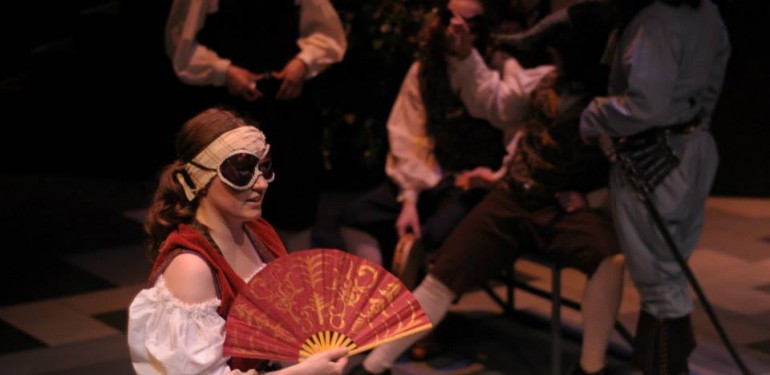Written by Fourth Estate Lifestyle Editor Genevieve Hoeler
The Mason Players cap off their season of historical exploration with 17th century Restoration comedy “The Rover,” written by England’s first professional female playwright, Aphra Behn.
The production itself proved to have a very strong cast and an inspiring technical design.
The script, however, is not only historical but incredibly dated. To remark on the play positively, it reaffirms the necessity for feminism. It is filled to the brim with mind-numbing misogyny and rape apologizing that may resemble a parody of 17th century culture but distances itself from a modern-day audience.
Set in Naples, Italy, “The Rover” is about a group of sailing English rogues led by the handsome rake, Willmore, that lands just in time for the Carnival. As the men arrive, the city of Naples buzzes around them as they snap at the heels of Naples’ women with eventual and comedic success.
As the faculty director, Kristin Johnsen-Neshati, described it in her director’s note, this play is “[a] comedy about partying, skirting the authorities, getting into fights and seeking true love.”
Whether or not Willmore or any of his men had any right to leave the pages of a textbook to wreak havoc on the Mason stage—or if they were actually seeking true love the way we envision the sentiment today— the production itself far surpassed the content of this play.
This play requires every character to not only have acting talent, but also comedic wit. The lead, Willmore, played by senior Philosophy major Aaron Sulkin, had a remarkable grasp on Behn’s complicated language. In a play where most of the men are reprehensible, especially himself, Sulkin woos the audience with a natural charm that makes the audience secretly cheer for the rogue in spite of themselves.
His entourage had to bear a similarly heavy burden to reconcile these ridiculously reprehensible characters to a modern audience; especially Bradyn Heck, senior Theater major, who played Blunt. In the second act, Blunt nearly rapes Florinda, played by senior Theater major Lorena Berger, as revenge for being slighted by a prostitute who stole his clothes, his sword and his dignity in the first act. His acting ability, comedic timing and ridiculous costumes (designed by Mailey Shimon) were the only redeeming qualities to Blunt’s character, but they were enough to keep audience members chuckling along with the piece.
With a banal apology later—for he did not know Florinda was a high-born lady and his good friend’s girlfriend— he is forgiven of his misdeed. Blunt mysteriously remains as fiercely loveable and charming as when the show begins.
Berger’s Florinda is witty and charming, even as almost every male character threatens to rape her—no exaggeration—she remains surprisingly steadfast and strong. If not for Berger’s skill, Florinda would seem incredibly weak, but thankfully this production took this character to more well-rounded level as she was battered from every angle by the men who govern and attempt to debauch her life.
Whether the audience liked the characters or not, each one who participated in the fight or flight scenes was able to shine beyond the confines of Behn’s play. The fight choreography by theater faculty member David Gaines was stunning. Somehow it managed to look effortless, cool, and gut-wrenchingly funny. The physicality throughout the entire play, whether sword fighting or running around in a hilarious game of cat and mouse, was especially exciting.
Although it was hard to really get a feeling of where this play was taken place, except when a character mentioned the city they were in, the set (designed by senior Theater major Cody Clarke) was a major asset.
The set separated into two tiers, the ground level where people could gather outdoors—in the garden or elsewhere in Naples—and a second level where all of the indoor scenes took place. Whether or not the set was truly safe, as there was no railing for the actors to hang onto around the set, it gave a unique vantage point to this play.
The sound design (designed by senior Theater major, Alec Henneberger) was simple—far simpler than the stage and lights (designed by Joseph Gugliuzza)—but effective. Like the set, it didn’t successfully place us in Naples, Italy. However, it was unobtrusive to the action and steadily bridged each scene together so that the play flowed seamlessly.
Although Aphra Behn’s “The Rover” should stay nested in a textbook for years to come, maybe forever, this production was charming and displayed the many talents of Mason’s theater department.
(Photo courtesy of Ruthie Rado)




